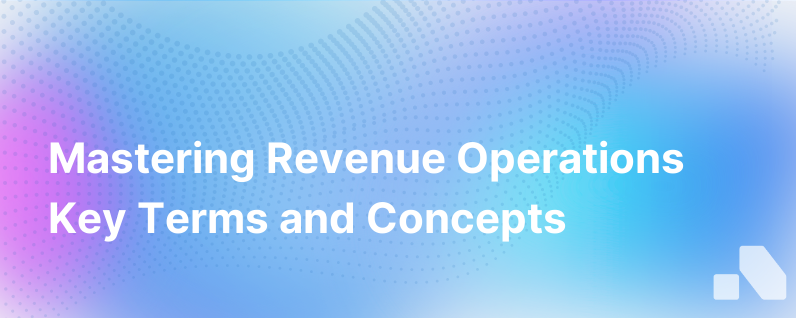
Understanding Revenue Operations: A Glossary for Today's B2B Professionals
Revenue operations, commonly abbreviated as RevOps, is the strategic integration of sales, marketing, and customer service operations to drive growth and operational efficiency. It's about breaking down silos between departments to align goals and strategies, maximizing revenue potential. Here's a comprehensive glossary of essential RevOps terms to know.
1. Revenue Operations (RevOps)
A business function that combines processes, data, and technology across marketing, sales, and customer service, focused on improving operational efficiency and revenue growth.
2. Sales Enablement
The process of equipping the sales team with tools, content, information, and best practices to sell effectively.
3. Customer Relationship Management (CRM)
A system for managing a company’s interactions with current and potential customers. It often utilizes data analysis about customers’ history to improve business relationships.
4. Key Performance Indicator (KPI)
A type of performance measurement that evaluates the success of an organization or a particular activity in which it engages.
5. Sales Funnel
The buying process that companies lead customers through when purchasing products. It's divided into several steps, which differ depending on the sales model.
6. Customer Lifetime Value (CLV)
A prediction of the net profit attributed to the entire future relationship with a customer.
7. Churn Rate
The rate at which customers stop doing business with an entity. It’s most commonly expressed as the percentage of service subscribers who discontinue their subscriptions within a given time period.
8. Unit Economics
The direct revenues and costs associated with a particular business model expressed on a per-unit basis.
9. Sales Quota
A sales goal; a set amount of selling that a salesperson is expected to meet over a given timeframe.
10. Pipeline
The step-by-step process salespeople use to convert a prospective buyer into a customer.
11. Forecasting
The use of historical data to predict future outcomes, such as revenue or sales performance.
12. Customer Acquisition Cost (CAC)
The cost associated with convincing a customer to buy a product/service, including research, marketing, and accessibility costs.
13. Lead Scoring
The process of ranking prospects against a scale that represents the perceived value each lead represents to the organization.
14. Conversion Rate
A metric that shows the number of conversions divided by the total number of visitors.
15. Sales Metrics
Quantifiable indicators used to assess the performance of a sales process.
16. Marketing Qualified Lead (MQL)
A lead judged more likely to become a customer compared to other leads based on lead intelligence.
17. Sales Qualified Lead (SQL)
A prospective customer that has been researched and vetted – first by an organization's marketing department and then by its sales team – and is deemed ready for the next stage in the sales process.
18. Revenue Funnel
The modern equivalent of the sales funnel. It acknowledges that post-sale customer success contributes to revenue.
19. Sales Velocity
The time it takes for a new lead to become a customer. This metric helps sales teams understand how quickly deals are moving through the pipeline.
20. Account-Based Marketing (ABM)
A strategic approach to business marketing in which an organization considers and communicates with individual prospect or customer accounts as markets of one.
21. Cross-Sell
The practice of selling an additional product or service to an existing customer.
22. Customer Success
Ensuring a customer achieves their desired outcomes while using your product or service.
23. Data Hygiene
The collective process of keeping records clean, accurate, and free of corrupt data.
24. Deal Slippage
When a deal that was expected to close in a particular period gets delayed to a future period.
25. Lead Nurturing
The process of developing relationships with buyers at every stage of the sales funnel and through every step of the buyer's journey.
26. Marketing Automation
The use of software and Web-based services to execute, manage, and automate marketing tasks and processes.
27. Operating Level Agreement (OLA)
Internal agreements outlining how various departments work together to meet needs within an SLA (Service Level Agreement).
28. Product Qualified Lead (PQL)
A lead that's experienced value with a product through a hands-on trial or freemium model and is likely to become a paying customer.
29. Return on Investment (ROI)
A performance measure used to evaluate the efficiency of an investment.
30. Service Level Agreement (SLA)
An agreement between a service provider and a client. Particular aspects of the service – quality, availability, responsibilities – are agreed upon between the service provider and the service user.
31. Total Contract Value (TCV)
The total value of a contracted revenue agreement, normalizing for duration.
32. Win Rate
The percentage of deals closed won compared to the total number of deals closed lost and closed won.
33. Lead Generation
The initiation of consumer interest or inquiry into products or services of a business.
34. Opportunity
A contact or account which has been qualified and has entered the sales pipeline.
35. Upsell
The practice of encouraging customers to purchase a comparable higher-end product than the one in question.
36. Buyer Persona
A semi-fictional representation of your ideal customer based on data and research.
Conclusion
In the fast-paced world of B2B sales, efficiency and alignment across all customer-facing departments is not just a nice-to-have, it's a necessity for growth. Revenue operations sits at the heart of this alignment, providing the strategies, tools, and processes needed to drive revenue growth and streamline operations.
Becoming familiar with the above RevOps terms provides a strong foundation for understanding how this holistic approach can benefit your organization. As technology continues to evolve, so too will the RevOps glossary, reflecting an ever-expanding discipline dedicated to maximizing revenue potential for B2B companies.